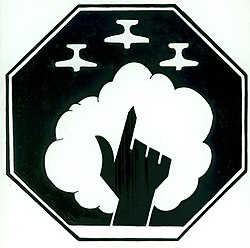A group is a military unit or a military formation that is most often associated with military aviation.
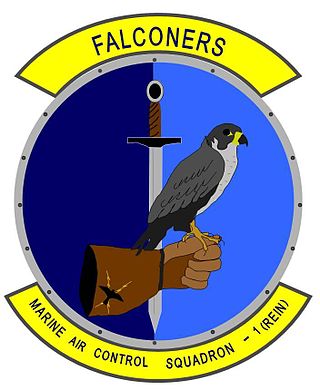
Marine Air Control Squadron 1 (MACS-1) is a United States Marine Corps aviation command and control squadron. The squadron provides aerial surveillance, air traffic control, ground-controlled intercept, and aviation data-link connectivity for the I Marine Expeditionary Force. It was the first air warning squadron commissioned as part of the Marine Corps' new air warning program and is the second oldest aviation command and control unit in the Marine Corps. The squadron is based at Marine Corps Air Station Yuma and falls under Marine Air Control Group 38 and the 3rd Marine Aircraft Wing.
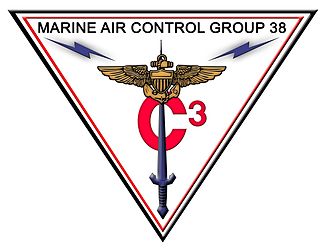
Marine Air Control Group 38 (MACG-38) is a United States Marine Corps aviation command and control unit based at Marine Corps Air Station Miramar that is currently composed of four squadrons and one battalion that provide the 3rd Marine Aircraft Wing's tactical headquarters, positive and procedural control to aircraft, and air defense support for the I Marine Expeditionary Force.

Marine Air Control Group 18 (MACG-18) is a United States Marine Corps aviation command and control unit based at Marine Corps Air Station Futenma that is currently composed of 4 squadrons and 1 HQ support detachment. The Marine Air Control Group as a whole provides the 1st Marine Aircraft Wings tactical headquarters, positive and procedural control, air traffic control, short range air defense and air defense control to aircraft for the III Marine Expeditionary Force.

2d Low Altitude Air Defense Battalion is an air defense unit of the United States Marine Corps. They are part of Marine Air Control Group 28 (MACG-28) and the 2nd Marine Aircraft Wing and are currently based at Marine Corps Air Station Cherry Point. The Battalion is composed of one Headquarters and Support Battery and two Firing Batteries.
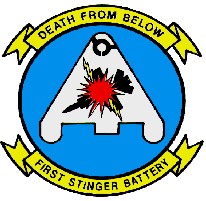
1st Stinger Battery was an air defense unit of the United States Marine Corps. When active, it was part of Marine Air Control Group 18 (MACG-18) and the 1st Marine Aircraft Wing and was based at Marine Corps Air Station Futenma, Okinawa, Japan. On December 7, 2006, Headquarters Marine Corps released a message stating that 1st Stinger would be deactivated during 2007. The battery was decommissioned on September 28, 2007.
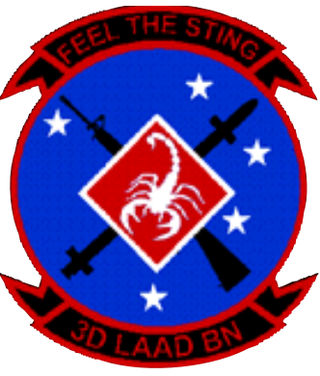
The 3d Low Altitude Air Defense Battalion is an air defense unit of the United States Marine Corps currently responsible for providing short range air defense. The battalion falls under the command of Marine Air Control Group 38 (MACG-38) and the 3rd Marine Aircraft Wing and is currently based at Marine Corps Base Camp Pendleton, California.

Marine Air Control Group 48 (MACG-48) is a United States Marine Corps aviation command and control unit based at Naval Station Great Lakes that is currently composed of 4 squadrons that provide the 4th Marine Aircraft Wing and Marine Forces Reserve with a tactical headquarters, positive and procedural control of aircraft, air defense and aviation command and control.

4th Low Altitude Air Defense Battalion was a reserve air defense unit of the United States Marine Corps. They were part of Marine Air Control Group 48 (MACG-48) and the 4th Marine Aircraft Wing and were based out in Pasadena, California.
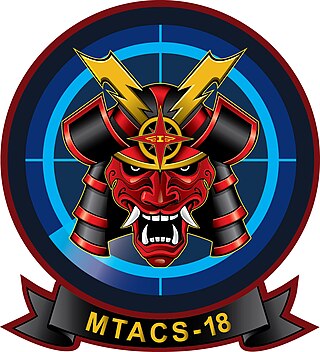
Marine Tactical Air Command Squadron 18 (MTACS-18) was a United States Marine Corps aviation command and control unit based at Marine Corps Air Station Futenma. The squadron provided the 1st Marine Aircraft Wings tactical headquarters and command post while deployed. MTACS-18 fell under the command of Marine Air Control Group 18 (MACG-18) and 1st MAW. The squadron was decommissioned on 9 June 2021 as part of the service's Force Design 2030. Responsibility for establishing 1st MAW's TACC now resides with the MACG-18 headquarters.

Marine Wing Communications Squadron 28 (MWCS-28) is a United States Marine Corps communications squadron. The squadron provides expeditionary communications for the aviation combat element of the II Marine Expeditionary Force. They are based at Marine Corps Air Station Cherry Point and fall under the command of Marine Air Control Group 28 and the 2nd Marine Aircraft Wing.
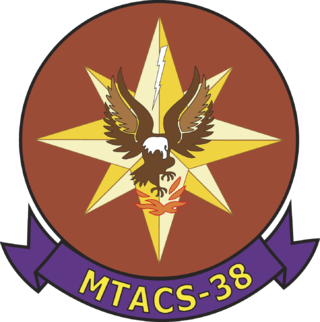
Marine Tactical Air Command Squadron 38 (MTACS-38), was a United States Marine Corps aviation command and control unit that provided the Tactical Air Command Center (TACC) for the 3rd Marine Aircraft Wing. The TACC is the senior agency in the Marine Air Command and Control System (MACCS) and serves as the operational command post for the commander of the aviation combat element and their staff. The squadron was based at Marine Corps Air Station Miramar, California and fell under the command of Marine Air Control Group 38 and the 3rd Marine Aircraft Wing.

Marine Wing Communications Squadron 38 (MWCS-38) is a United States Marine Corps communications squadron. The squadron provides expeditionary communications for the aviation combat element of the I Marine Expeditionary Force. They are based at Marine Corps Air Station Miramar, California, and fall under the command of Marine Air Control Group 38 and the 3rd Marine Aircraft Wing.

2nd Light Antiaircraft Missile Battalion was a United States Marine Corps air defense unit equipped with the medium range surface-to-air MIM-23 HAWK Missile System. 2nd LAAM was based at Chu Lai during the Vietnam War and was responsible for providing air defense for the Marine Corps in the northern part of the I Corps sector. After Vietnam, the battalion was based at Marine Corps Air Station Yuma, Arizona and fell under the command of Marine Air Control Group 38 (MACG-38) and the 3rd Marine Aircraft Wing. 2nd LAAM Battalion's last combat tour saw it providing air defense for the Marine Corps area of operations during Operation Desert Shield/Desert Storm. 2nd LAAM Battalion was deactivated on 1 September 1994 as part of the post-Cold War draw down of forces and because the Marine Corps had made the decision to divest itself of its medium-range air defense. The battalions personnel and equipment were transferred to 1st Light Antiaircraft Missile Battalion.

3rd Littoral Anti-Air Battalion is a United States Marine Corps aviation command and control and air defense unit that is optimized for operations in the first island chain. The battalion is based at Marine Corps Base Hawaii and falls under the command of the 3rd Marine Littoral Regiment and the 3rd Marine Division.

The History of ground based air defense in the United States Marine Corps dates back to the early 1930s with the establishment of the Advanced Base Force. World War II would be the high-water mark for air defense units when 20+ defense/anti-aircraft battalions were formed with many seeing significant action throughout the Pacific Theater. Following the war, the Marine Corps divested itself of most of its air defense capability at a time when the service was facing deep personnel cuts and fighting for its institutional survival. Beginning in the early 1950s the Marine Corps aligned itself with the Navy and their development of surface-to-air missiles (SAMs). The Marine Corps retained both flak weapons and SAMs throughout the 1950s until the fielding of the MIM-23 Hawk Missile System in 1960. The HAWK Missile was employed by Light Antiaircraft Missile (LAAM) battalions and remained a mainstay of Marine Corps ground based air defense for the next four decades.
Marine Aircraft Group 43 (MAG-43) was a fixed wing aviation group in the United States Marine Corps Reserve based at Naval Air Station Joint Reserve Base Willow Grove, Pennsylvania.
The Marine Air Command and Control System (MACCS) is the aviation command and control agencies of the United States Marine Corps that provide the Aviation Combat Element (ACE) commander with the means to monitor, supervise, and influence aviation operations in support of the Marine Air-Ground Task Force. The command and control agencies of the MACCS are provided by the squadrons and battalions of the Marine Air Control Groups that are present within each Marine Air Wing. The capabilities resident within the MACCS allow the MAGTF commander to safely conduct aviation operations, facilitate timely maneuver and prosecution of fires and ultimately retain full control of their entire area of operations. MACCS agencies are also responsible for coordinating Marine Corps aviation operations with joint, multinational and civil aviation.

